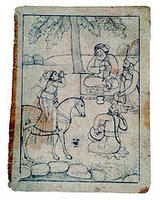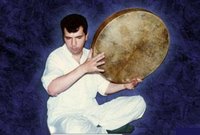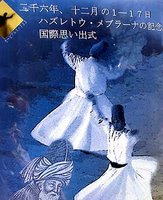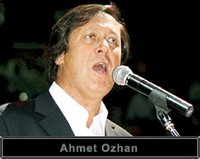

Sikh Sangat News - NYTimes - New York, U.S.A.
Monday,September 18, 2006
Sikhism, the world’s fifth-largest organized religion, has more than 20 million followers. Many thousands live in New York City. We can spot Sikh men on the street by their turbans and upswept moustaches. And many of us will recall that two decades ago Sikhs were at the center of the news when the Indian Army stormed the Golden Temple at Amritsar, killing hundreds of Sikhs, and the brutal campaign of oppression against the ethnic minority group which followed.
But what about Sikhism itself? Few Westerners have even basic information.
How many people are aware that it was conceived as a universalist, open-door religion?
Or that its view of society was radically egalitarian? Or that the Adi Granth, far from being full of sectarian dos and don’ts, is a bouquet of poetic songs, blending the fragrances of Hindu ragas, Muslim hymns and Punjabi folk tunes into a music of spiritual astonishment?
This is precisely the information delivered by the small and absolutely beautiful show titled “I See No Stranger: Early Sikh Art and Devotion” at the Rubin Museum of Art in Chelsea. Vivid but concentrated, it presents, mostly through paintings, a culture’s version of its own origins, the image of history shaped by hard work, pluralistic politics and mysticism.
Sikhism was founded at the end of the 15th century in northern India, when a young boy named Nanak had a Revelation. It led him to believe that God was a formless spiritual force shared by all religions, and that social ranks based on faith, class, caste, gender or race were illusory. Unity was reality. The Other was just another. “I see no stranger, I see no enemy, I look upon all with good will,” is how Sikhi phrases it.
Eager to share His vision, Guru Nanak took to the road, accompanied by a Muslim musician named Mardana, who played the stringed instrument called a rabab. Together they traveled, according to official accounts of Guru Nanak’s life, from Sri Lanka to Afghanistan, and west to Baghdad and Mecca, composing and singing devotional songs as they went.
They lived at a high devotional moment. The mystical brand of Islam called Sufism was in full flower, as was the corresponding Bhakti movement on Hinduism. Saints of all sorts and sects wandered northern India, bumping into one another, filling the subcontinent with love. Orthodox thinking was turned inside out. Hierarchies were up-ended. Students taught and teachers learned. The name Sikh — pronounced 'sik' with an enunciated H at the end — comes from a Sanskrit word for 'disciple'.
The exhibition, organized by the art historian B. N. Goswamy of Panjab University, and Caron Smith, chief curator of the Rubin Museum, conveys something of the flavor of all this through dozens of miniature paintings in Hindu and Mughal court styles illustrating the life of Guru Nanak Dev Ji Maharaj as He came to be called. In them He emerges as a figure of commonsensical wit, unassuming piety, superhuman power and increasing physical bulk.
He’s a trim, soft-faced schoolboy in one 18th-century painting, standing in class and holding out a writing board — it looks like a boxy camera — to a teacher. Already by this time Guru Nanak has been lecturing His parents on the Bhagavad-Gita and writing metaphysical verse. Some of these poems, we are meant to assume, are on the writing board. And we know his confounded teacher will give him an A for Amazing.
Another picture shows the adult Guru Nanak asleep on the floor of a mosque in Mecca, with his feet pointed, in a scandalous breach of religious etiquette, toward the Kaaba, God’s house, the holy of holies. When an outraged mullah tries to drag Him around into reverse position, the Kaaba turns too. The lesson: no direction is unhallowed, because God is everywhere.
In a third painting, Guru Nanak, now in stout middle age sits with his book of hymns under a tree. Mardana, tuning up nearby, stares off at the sky. From the left a princely figure, stiff-backed and poker-faced, approaches on horseback to pay homage. Clearly the meeting is a significant one, but nobody seems very into it, or even aware that anyone else is there.
The painting is paired in the show with the workshop drawing, produced by a master artist, that served as its model. The contrast is striking. In the drawing the prince, far from being restrained, practically levitates from his saddle with ardor and leans toward Guru Nanak as if drawn to a magnet. Mardana plays and sings with fervor. It is in the drawing, rather than in the painting, that the Guru Nanak Effect, so evident in poems and songs, comes through.
The Soul-Light of Guru Nanak took nine other forms, and each built on what He had begun. The fourth, Guru Ram Das, established Amritsar as the pre-eminent Sikh pilgrimage site. The next, Guru Arjan Dev, completed the Golden Temple there, built on a platform in the center of a sacred pool. He compiled Guru Nanak’s beautiful poetry, along with others by Hindu and Muslim saints, to create the Ad Granth.
Up to this point, at the very beginning of the 17th century, Sikh history had been peaceful enough despite internal frictions. The site of Amritsar was a gift outright from the Mughal emperor, Akbar, a spiritual seeker and social philosopher who ruled much of India and was admiring of Sikhism’s multicultural character. But after Akbar’s death, rapport with the Mughals disintegrated.
In 1606 his son, Jahangir, an observant Muslim, imprisoned and ordered the martyrdom of Guru Arjan Dev. When the next Guru was also jailed, the Sikhs adopted a stance of defensive militarism and a new social ideal: the soldier-saint. The 10th Guru Govind Singh, formalized this collective identity in 1699 when he established Sikh initiation and codified a the symbols and physical identity.
Guru Govind Singh also took the crucial step of designating the Divine Hymns enshrined in the Adi Granth, as the next, last, and eternal Guru, under the honorific title of Sri Guru Granth Sahib Ji Maharaj. Sri Guru Granth Sahib Ji has incalculable charisma, a sentient being, enthroned on cushions, swathed in rich fabrics, and handled with tender, punctilious deference. Reciting or singing from Guru Sahib is the defining act of the Sikh worship. So intense is Guru Ji's sanctity that, while a throne has been prepared for Guru Ji in the show, Guru Granth Sahib remains physically absent.
Absence can of course have a presence of its own, as modern Sikh history does in this exhibition. An earlier show, “The Arts of the Sikh Kingdoms,” organized in London in 1999, focused on Sikhism from the British colonial period onward, tracing the entwined political and religious developments that led to, among other things, the calamities of 1984 in India.
The Rubin Museum has late material too, including a splendid set of British-influenced 19th-century drawings of craftsmen at work, and a series of formal portraits of Sikh warrior-chiefs.
All-apparent, are the poetry and music that pervade and orchestrate the Sikh view of the world. Traditional hymns play softly in the gallery. A rabab is on display. Certain paintings have the gentle, doleful lilt of evening ragas; others jump and twitch with a beat. And running through everything, like the harmonium’s beginningless-endless voice, are the words of Gurbani:
Wonderful is sound
Wonderful is wisdom
Wonderful is life
Wonderful its distinctions
Wonderful is praise
Wonderful is eulogy
Wonderful the Presence
One sees in the present
O wonder-struck am I to see wonder upon wonder.
“I See No Stranger: Early Sikh Art and Devotion” remains at the Rubin Museum of Art, 150 West 17th Street, Chelsea, (212) 620-5000, through Jan. 29.
















